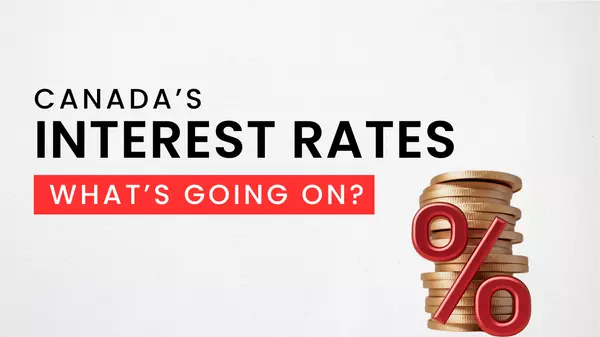Interest Rates In Canada: What’s Going On, and What’s Next?
Canada’s Evolving Interest Rate Landscape: What to Expect in the Months Ahead
In recent months, the Bank of Canada (BoC) has been on a mission to stabilize the Canadian economy by adjusting interest rates. The latest move—a half-point cut in October, bringing the policy rate to 3.75%—indicates the BoC’s readiness to support economic growth in the face of low inflation and tepid GDP growth. This blog post dives into the current interest rate environment in Canada, examining the BoC’s recent decisions, economic indicators, and expectations for further rate cuts as we approach the end of 2024.
A Look Back: The October Rate Cut
The BoC’s recent half-point cut was a notable shift in its gradual easing cycle, which had initially seen three consecutive quarter-point cuts since June. The primary driver behind this more aggressive cut was the rapid decline in inflation. Consumer Price Index (CPI) inflation fell to 1.6% in September, well below the BoC’s 2% target, marking the first significant undershoot in years. Governor Tiff Macklem emphasized that this move was necessary to prevent an excessive slowdown in the economy, as low inflation paired with weak growth signals an urgent need to balance supply and demand.
Macklem remarked at the October press conference, “We took a bigger step today because inflation is now back to the 2-per-cent target, and we want to keep it close to the target.” By making a decisive cut, the BoC aims to prevent economic stagnation and keep inflation from falling further, potentially boosting consumer spending and investment.
Key Economic Indicators to Watch
As we approach the next interest rate announcement on December 11, several data points will be crucial in guiding the BoC’s decision:
-
August GDP Data (October 31): August’s GDP numbers, released by Statistics Canada, will offer insight into the economy’s performance and help shape the BoC’s policy stance. Weak GDP growth in recent months has reinforced the case for easing, with third-quarter growth at only 1.5%, below the economy’s potential.
-
Employment Data (November 9): Job market conditions will be critical. While employment remains steady, any signs of weakening could prompt additional action from the BoC to support labor demand and economic resilience.
-
Inflation Data (November 19): Inflation will continue to be a key factor. Following the October dip, analysts expect inflation to hover near the 2% target. Sustained low inflation will likely encourage the BoC to maintain its easing bias.
As Macklem has stated, these data points will influence “the timing and pace of further interest rate cuts.” The BoC remains committed to a cautious approach, waiting for economic data before making further cuts, especially as it assesses whether the Canadian economy is recovering from recent softness.
The Influence of U.S. Monetary Policy
The U.S. Federal Reserve’s decisions also impact the BoC’s policy, as Canada’s economy is closely linked to the United States. Following a half-point cut in October, the Fed is expected to reduce rates by another quarter-point at its next meeting on November 7. However, Canada’s rate-cutting cycle has been more aggressive, partly due to the relative strength of the U.S. economy compared to Canada’s.
Economists have noted that the BoC must be cautious of diverging too far from the Fed to avoid putting downward pressure on the Canadian dollar. As Tu Nguyen, economist with RSM Canada, highlights, “deviating too far from the Fed risks causing the loonie to lose even more value.” While a weaker dollar can boost exports, it can also increase the cost of imports, potentially leading to inflationary pressures. Thus, while the BoC has room to cut, it must balance domestic needs with external pressures from the Fed’s policy direction.
Perspectives from Economists on Further Cuts
Economists widely agree that additional rate cuts are likely, though there’s some debate over the size of future cuts. Here’s a look at differing perspectives:
-
Royce Mendes, Desjardins Securities: Mendes notes that while the October cut was bold, the BoC may prefer 25-basis-point cuts moving forward. With U.S. economic strength in mind, Mendes believes the BoC is inclined to ease cautiously.
-
James Orlando, TD Economics: Orlando sees further cuts on the horizon, noting that inflation has dropped below target, and GDP growth remains slow. He projects an additional 150 basis points of cuts through 2025, bringing the rate closer to 2.25%.
-
Stephen Brown, Capital Economics: Brown believes another 50-basis-point cut in December is possible, as Canada’s economy faces excess supply and modest growth projections. He argues that a more “neutral” policy stance is warranted.
How Rate Cuts Could Impact the Housing Market and Mortgages
Lower interest rates are generally favorable for the housing market, as they reduce borrowing costs for homebuyers. However, the impact on mortgage rates may be slower than anticipated. While variable-rate mortgage holders will experience immediate relief, the recent cut has had limited impact on fixed mortgage rates, which are more closely tied to bond yields.
Robert Kavcic, senior economist at BMO, notes that “five-year mortgage rates have been hovering above the 4 per cent mark” and may not dip significantly until more cuts occur. Additionally, recent federal changes to mortgage rules, effective mid-December, aim to stimulate the housing market. These combined factors could support a gradual recovery in housing demand, although affordability remains a key issue for many buyers.
The Road Ahead: What to Expect in December and Beyond
The BoC’s next steps will depend heavily on the incoming data. If the Canadian economy shows signs of growth recovery, the central bank may proceed with smaller, more measured rate cuts. However, if economic indicators continue to show weakness, a larger 50-basis-point cut may be on the table in December.
The BoC’s updated projections for GDP growth and inflation will provide insight into its policy outlook. Notably, the central bank aims to avoid an economic recession while supporting consumer confidence. The BoC’s conservative approach to inflation and economic stability suggests that cuts will likely continue, albeit at a cautious pace, into 2025.
Conclusion: A Time of Transition for the Canadian Economy
The Canadian economy stands at a crossroads, with low inflation and slow growth prompting the BoC to ease policy more aggressively than expected. While the economy is grappling with excess supply and slow demand, the BoC’s rate cuts offer hope for a gradual recovery. Moving forward, close attention to GDP, employment, and inflation data will guide policymakers as they navigate this uncertain environment.
For Canadians, these rate cuts mean potential relief in borrowing costs, particularly for those with variable-rate mortgages. However, fixed-rate mortgage holders and prospective buyers may need to wait until rates drop further to see significant benefits. The BoC remains cautious in its approach, focusing on stabilizing the economy without reigniting inflation—a delicate balance that will shape Canada’s economic landscape well into 2025.
For more updates on Canada’s interest rates and economic outlook, stay tuned for the BoC’s next announcement on December 11.
Disclaimer: The information provided in this blog post is for general informational purposes only and does not constitute personalized real estate, financial, or legal advice. Every individual's situation is unique, and the strategies or tips discussed may not be suitable for all circumstances. We recommend consulting with a real estate professional, accountant, or lawyer before implementing any approaches mentioned to ensure they align with your specific needs and circumstances.
Recent Posts











